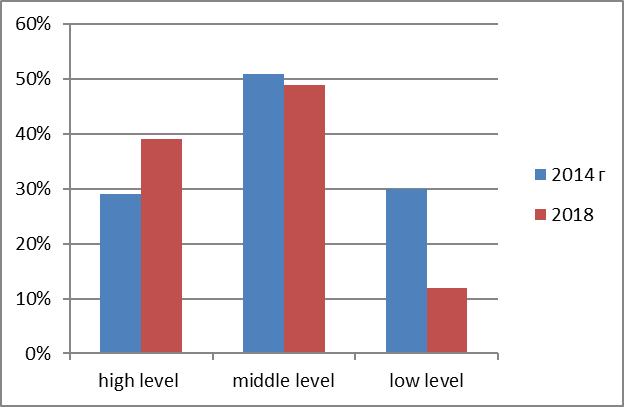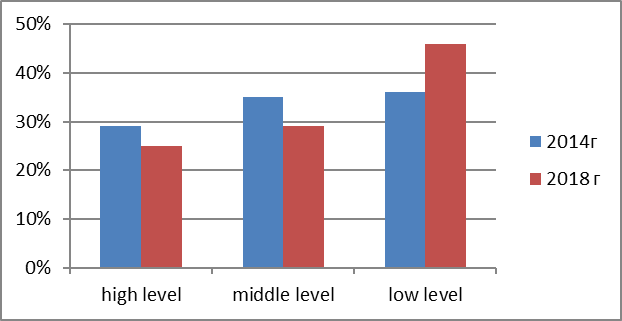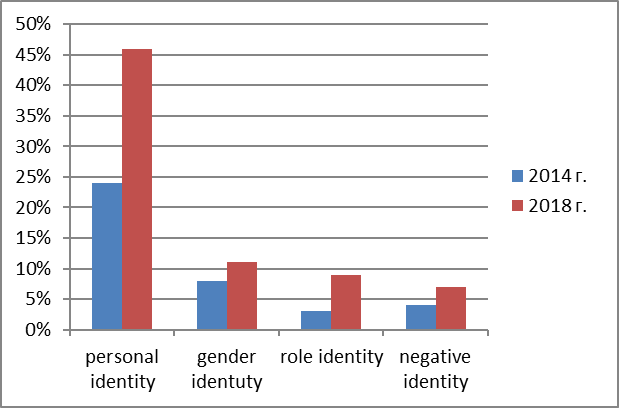Abstract
The article presents the data revealing the general trends and the phenomenology of cognitive and personal development of six-eight-year-old children over the past five years. It shows stable patterns that retain their significance at the present time, as well as the transformations that have occurred in the content and direction of the main lines of children's mental development - cognitive, emotional and personal. The data of an empirical study of children of preschool (N=180) and primary school age (N=180) showed significant changes in the ratio of schematic and verbal thinking of children. With some decrease in verbal thinking, the level of figurative and, especially, schematic thinking increases significantly. This leads to the fact that the overall level of intellectual development also significantly increased in all age groups. The obtained materials show the large role of computers in changes of the structure of intellect. With a positive impact on intellectual development, immersion in the Internet space leads to negative effects of reducing the barrier between reality and the virtual gaming world. Increased reflection leads to changes in the content of the children’s identity, which becomes more differentiation and structured. At the same time the role and gender identity is increasing, which is associated with a more conscious attitude of children to their place in the system of social relations. The impact of social transformations affects both - the overall anxiety and increase of the aggressive elements in behavior, especially among girls.
Keywords: Informational spacecognitive and personal development
Introduction
Mental development of children in the modern information space
The increasing importance of the information and media as the most important socialization institution opens a wide range of new resources as well as new possibilities for the cognitive and personal development of children. From the first months of life, the child is faced with the achievements of civilization, which open up new opportunities. These opportunities are associated with the emergence of information technologies, which create new forms and types of information products for children (Martsinkovskaya, 2017). Therefore, the problem of childhood, the phenomenology and the general trends of children’s development in the modern world remains one of the most actual (Dubovskaya, 2014). However, it must be stated that now we don’t have enough data about general trends in all spheres of mental development at all stages of ontogenesis (Matyushkin, 2003).
Cognitive development of modern children
One of the main features of psychological characteristics of 6-8-year-old children is the development of arbitrariness of the leading mental processes. This fact was noted by almost all scientists. Despite significant infantilism, the development of arbitrariness continues to be the main line of mental development, turning involuntary cognitive processes into manageable ones. Perhaps this line become even more vivid due to new types of games and toys, in which the orientation plays an important role. The new toys, including transformers, as well as the new computer games focuses precisely on orientation. And it is not orientation in specific subjects, but in their generalized etalon forms. About the importance of such games which have a significant impact on the transition of figurative thinking to a higher level of schematic thinking, wrote Wenger (1976) who came to the conclusion about the existence of a model form of thinking, intermediate between figurative and logical thinking.
In figurative thinking, children, while generalizing or classifying objects, can rely not only on essential but also on secondary qualities, then schematic thinking implies the ability of children to identify the main parameters of the situation and objects, on the basis of which they are classified and summarized (Zaporozhets, 1986). However, this possibility exists in children only if the objects are present in the external plan, in the form of diagrams or models. Therefore, we can say that many types of modern games and toys, including computer games, are developing ones, stimulating the formation of model, schematic thinking. An important aspect of these games is the formation of visual-motor coordination, which contributes not only to intellectual development, but also to the readiness to school.
Internet as instrument mental development
Now we can also slate that for a large group of children Internet is not only an entertainment, but also a way to get information and even learning. For example, there was shown possibility of Skype education. This method of learning is becoming quite popular in families where parents feel the insufficiency of their knowledge and capabilities in order to provide complete information for the harmonious development of their child. Therefore, many traditional tasks of learning and development of preschoolers can be solved more diversely through the use of Skype technology. It is also emphasizes that the use of Skype communication as a tool for teaching can be used in communication with children with disabilities, as well as a way to overcome the lack of communication with parents and other significant adults.
Problem Statement
With the undoubted importance of researching new patterns of development of the psyche at all stages of ontogenesis, the period of preschool childhood remains one of the most important. It is at this time that the basic structures of the child’s personality, the foundations of his sociocultural identity and attitudes towards the world and society are formed. Therefore, the role of preschool childhood in preparing the child for full-fledged activities in the new changing world, the formation of an active, individual and creative position cannot be overestimated. The role of adults is, first of all, in the translation of significant values and norms of society that help the positive socialization of children.
Research Questions
The fact that small children are already well-versed in gadgets, which adults and especially elderly people cannot always cope with, demonstrates the need to study new patterns of perception and processing of information by children of preschool and primary school age. The question also arises how this information influences their cognitive and personal development and what new elements appear in the structure of their intellect and content of identity.
Purpose of the Study
To study changes in the structure of the intellect of children of preschool and primary school age
Investigate the content of the identity of modern preschoolers and young pupils.
Research Methods
The test “Schematic construction” (Martsinkovskaya, 2010);
The test “Pictogram” (Martsinkovskaya, 2010);
The questionnaire “My past-now-future” (Martsinkovskaya, 2017);
The test “Make a picture” (Martsinkovskaya, 2017).
Findings
Cognitive development
The results of diagnostics of the cognitive development show an increase in figurative-schematic thinking. So, in 2018, a high level of schematic thinking was noted in almost 40% of children, while in 2014 only a quarter. The number of children with a low level of schematic thinking has also decreased (see Fig.

According to the level of verbal-logical thinking, developmental tendencies have the opposite character (see Fig.

The analysis of all results obtained in 2014 and 2018 show that the overall level of cognitive development has grown. So, in 2018, more than a third of children (37%) have a high level of intellectual development and 45% are average. At the same time, in 2014, a high level was diagnosed only in 31% of children, and the average - in 39%. Accordingly, the number of children with low levels of intelligence decreased significantly (from 30% to 18%). Our data also showed that the least changes in the structure of cognitive development affected memory - neither the total volume nor the level of voluntary / involuntary memorization.
Significant changes can be noted in the nature of perception, since even non-systematic studies show an increase in the role of perception in the general structure of cognition. We can also see that on the one hand, the world-image becomes more and more generalized. On the other hand, the images themselves become less differentiated, so the children see only the most important elements of the objects. This helps the development of the operational side of the activity but makes it difficult to establish an overall picture of the environment.
Perhaps this data is connected with the fact that Internet is beginning to exert ever increasing influence on all aspects of the mental development of children from an early age. Especially it is connected with the fact that for many children the figurative (schematic) thinking becomes gradually leading and the world-image gradually changes - from verbal to figurative. It seems that operations and forms of thinking do not determine (or determine to a lesser extent than in previous years) the way children interact with the world.
This material proves that the informational space of children is not limited by television or books, but it is much more diverse. The consequences of connecting young children with Internet cannot be unambiguously assessed. Undoubtedly, the developing potential of computer technologies is very great, but there are also negative consequences. The ambivalent influence of Internet is manifested in the fact that, on the one hand, communication in the network, the emergence of new friends (and the process of virtual communication has an undoubted tendency to rejuvenate the recipients) is a positive trend. New information, the opportunity to visit different places in which the children has not yet been in reality, to see new things, expand and enrich the consciousness, is, naturally, a positive fact. On the other hand, the interest for virtual games, giving a feeling of “spare” lives, “spare options” of building one’s own destiny, not only reduces the sense of real risks, but also the sense of reality as such, make children extremely vulnerable for stress and unfavorable life situations.
Emotional and personal development
The character of the emotional development of modern children has changed significantly. It was increased knowledge of how to express emotions and emotional states, as well as general awareness of the number of emotions, the ability to "read" the emotions of others and express emotional state. The level of empathy has also increased, especially in relation to peers, the elderly and domestic animals. Apparently, this is due to the more pronounced loneliness of the child in the family, less communication with peers and, accordingly, an increase in the proportion of communication with pets, which appear much more often in families.
Another striking characteristic of the modern children's emotional sphere is the fact that the most active emotional mechanism became the suppression of emotions. Changes in emotion’s simulation are less pronounced, and the activity of copying and infecting with emotions has not changed much. This indicates that children try not to show their real experiences, either by suppressing or masking them, at the same time demonstrating the emotion that parents expect from children.
The study of social assessments and emotional experiences of children showed that a significant part (more than a 30%) of children fully positively assess the world around them and adults. This number has not changed much over the past five years. At the same time, in 2014 most children adopted the rules and norms transferring by adults. In 2018 increased the negative assessment of adults (11% negatively assess their relatives, and 19% - teachers). At the same time, the number of negative peer evaluations has not changed much.
The study of the personal development of children shows that the level of self-esteem has significantly increased, although its adequacy has increased slightly. Personal activity, as well as self-esteem, became less dependent on external factors than before.
This is most clearly manifested in the number of parameters given by children in self-description. It is important fact that 5 years ago, objective parameters prevailed in the content of children’s identity, and in 2018 subjective parameters start to play a greater role. The dominance of subjective criteria in identity of modern children seems to be related to the fact that they distinguish more personal and individual characteristics and correlate them well with their own self-image.
If in 2014 76% children, regardless of their place of residence, saw only positive qualities in themselves and did not realize their shortcomings, then in 2018 only 54% of children rated themselves uniquely positive, the rest saw also negative qualities. That is, in 2014 24% of children had a differentiated view of themselves, and in 2018 - 46%. Apparently, this is due to a wider and more diverse social circle, including through the expansion of the information space.

In 2014 only 4% of children had negative identity. Five years later 7% of children have a negative identity. These data allow us to state that the emotional component of personal identity is relatively stable; most children tend to accept themselves, which is a necessary condition for personal growth and successful socialization. Therefore, an increase in the number of children with a negative attitude towards themselves (not just the presence of negative qualities in the content of personal identity) is a rather alarming fact (see Fig.
The obtained data also showed that there are differences in the exchange of experience and interaction of adults with children in megalopolises and small towns. This is confirmed by the results of the study of the identity of the children living in a large and small city. The findings suggest that the self-image of children living in the megacity is more negatively colored and they use negative characteristics in their self-descriptions - lazy, I do not obey my mother, etc. The self-image of children from a small city is more positive as well as more holistic, which is manifested in sustainably more positive parameters in self-description.
The dominance of personal identity is clearly seen in both groups of children (fig.3). At the same time, children living in the megalopolis more self-dominated than children from small cities. These data may indicate a more egocentric orientation in communication between children from a large city and a lack of interest in contacts with partners. There are also differences in the dreams about the future. Children living in the megalopolis are more focused on the future and see it in more detail, while those from a small town are less optimistic, and their ideas about their future are more unclear. We can see that this trend continues at an older age.
The study of aggression and conflict has shown that most children are able to resolve conflict situations, while remaining within the framework of social normativity. At the same time, the level of aggressiveness remains high (43% have a high level of aggressiveness, and 39% - medium) and has changed little over the past 5 years. This may indicate that data on conflict resolution methods are known rather than actual motivation. It is alarming that in recent years the number of aggressive girls has increased by almost 30%, although the level of aggressive behavior in boys remains constant. Perhaps it is due to the fact that in recent years the attitude towards success has been associated with aggressive behavior regardless of gender, which, apparently, has led to an increase in aggressiveness among girls.
Conclusion
The overall level of cognitive development of children has increased significantly over the past 5 years, which is associated with an increase in the proportion of schematic thinking in the overall structure of intelligence.
Modern computer learning games have a positive effect on the cognitive development of both pre-schoolers and younger schoolchildren, as they form the ability for orientation and processing of information that is important for intellectual development.
The negative impact of computer games is manifested primarily in reducing the barrier between real and virtual danger.
General trends in the development of identity are associated with increasing abilities to reflect, which leads to positive dynamics and in the content of personal and social identity, as well as to a more flexible attitude towards one-self.
Social uncertainty and instability lead to an increase in anxiety of children and, at the same time, to increase of aggressive behavior, which is especially noticeable among girls
Acknowledgments
Grant RSUH 01-129/from 21.03.19.
References
- Dubovskaya, E.M. (2014). The transitive society as a factor of personality socialization. Psychological study, 7(36). Retrieved from http://psystudy.ru/index.php/eng/2014v7n36e/1028-dubovskaya36e.html
- Martsinkovskaya, T.D. (2010). Psychodiagnostics of children's development. Moscow: Soliton.
- Martsinkovskaya, T.D. (Ed.). (2017). Identity in everyday and transitive world. Moscow: MPGU Press.
- Matyushkin, A.M. (2003). Thinking, learning, creativity. Moscow: Publishing house MPSI.
- Wenger, L.A. (1976). Genesis of sensory abilities. Moscow: Pedagogy.
- Zaporozhets, A.V. (1986). Selected psychological works. Moscow: Pedagogy.
Copyright information

This work is licensed under a Creative Commons Attribution-NonCommercial-NoDerivatives 4.0 International License.
About this article
Publication Date
14 July 2019
Article Doi
eBook ISBN
978-1-80296-063-1
Publisher
Future Academy
Volume
64
Print ISBN (optional)
-
Edition Number
1st Edition
Pages
1-829
Subjects
Psychology, educational psychology, counseling psychology
Cite this article as:
Martsinkovskaya*, T., Gavrichenko, O., Soboleva, M., & Preobrazhenskaya, S. (2019). Dynamics Of Children’s Cognitive And Personal Development In The Information Space. In T. Martsinkovskaya, & V. R. Orestova (Eds.), Psychology of Subculture: Phenomenology and Contemporary Tendencies of Development, vol 64. European Proceedings of Social and Behavioural Sciences (pp. 349-355). Future Academy. https://doi.org/10.15405/epsbs.2019.07.45
